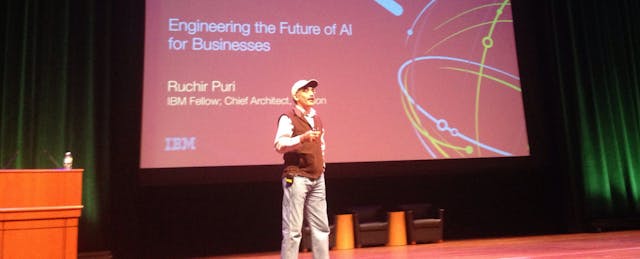Artificial intelligence (AI) systems can recognize your speech like Siri or identify images like Facebook, but these types of machine intelligences are built on statistical approximation, using loads of data to make educated guesses. Though statistical approximation was a significant technological advancement for devices, experts at Future Lab’s AI Summit in New York City believe that it is time to expand the bounds of artificial intelligence—to democratize it—by “engineering knowledge.”
“Working with kids gives you grounding. They ask questions because they are not shy,” says IBM Watson’s Chief Architect, Dr. Ruchir Puri, in an interview with EdSurge. “The questions are simple, but very probing, like: ‘Watson gave me this answer, why?’ Unfortunately, AI cannot explain why,” he continues.
For Puri, that is the next level of AI—its ability to not only say what something is, but to reason and understand the intent of its being, to answer the ‘why’ question. Computer scientists have yet to engineer knowledge in that capacity, but they want to. The desire to build cognitive understanding is growing, but many experts assert that in order to do it, the study of AI has to become more interdisciplinary. This means it must open up to individuals who are not computer scientists, so people in other disciplines can begin to impact its development.
The democratization of AI is something Puri is passionate about. His goal with Watson is to make AI’s functions more consumable for general audiences, moving it out of the higher education space. “A lot of AI functions are targeted towards Ph.D.s, it is very complicated,” explains Puri. “If I am not interested in knowing the details, I should still be able to derive the benefit of AI, that's what I call consumability.” For Puri, consumability is measured on a fifth-grade level, meaning if a fifth grader (who knows a little bit of Python) can understand the applications of AI, then the content is on a consumable level. The mission to make AI consumable is the reason Puri spends his free time coaching a group of fifth-grade girls in Westchester, New York, for the First Lego League robotics competition.
For the most recent competition, Puri supported the girls to come up with an AI-enhanced device that prevents birds from hitting glass buildings—an issue that kills thousands of birds each year. “You can put the device on the side of a building, and when it detects motion, it takes a picture,” Puri explains, “If the picture is a bird, it identifies the bird species and sends it to Watson. Watson then tells the machine what species it is, and based on that, the predator call of that bird blast through the speakers on the device and scares the bird away.” The girls who work on this project with Puri come from diverse interests; there is no requirement that they have to desire to be computer scientists.
Puri believes that understanding computers is not only for computer scientists. “Computer education will become a basic education in society. I am fully convinced,” says Puri. His participation in the Lego League contest is one way he educates the general public about AI. However, Puri specifically targets girls because he sees a gender gap in his field and wants to combat it. “In engineering, there aren’t that many girls. Until my daughter (who is a member of the First Lego League) got interested in this, I didn’t realize that there were biases in society,” explains Puri, “If you are a girl and really smart in math, people will still say: ‘You are there because you’re a girl.’”
In Puri’s experience, young girls are sometimes discouraged from joining spaces where there are no other girls, so he works with cohorts to promote their computer science interest. “Girls provide a very diverse perspective. It’s not just about IQ—it’s also about EQ, and as society moves forward, EQ will become more important. Diversity in EQ is good in every field,” says Puri.
Puri sees more academic programs incorporating tenets of AI into their curriculums. His other daughter, a 10th grader, spends a lot of time studying the intersections of biology and AI. Puri hopes human and machine interactions will normalize as artificial intelligence becomes more interdisciplinary. “Biology, psychology, behavioral science, computer science, you name it—AI needs input from every field,” he says.
But to get more students on board, Puri thinks educators should engage students with the “fun” applications of AI, before bogging them down with equations. “You grab them first before your turn them away with equations. Drones and birds, those are fun,” says Puri. “So what if I know one more equation than you? You bring in a perspective I would never have. It’s about solving problems.”


